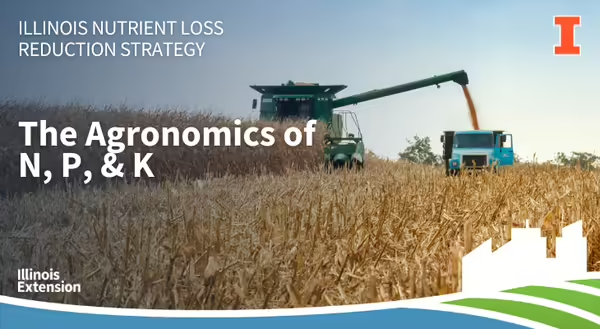
As harvest wraps up, many farmers are turning their attention to fall fertilizer applications. Managing nitrogen (N), phosphorus (P), and potassium (K) levels is crucial, especially with variable weather and input costs. In episode 67 of the Illinois Nutrient Loss Reduction Podcast John Jones, University of Illinois Soil Fertility Specialist and Agronomy professor, discussed fertilizer application strategies for the fall.
Timing nitrogen applications
When applying nitrogen in the fall, timing is critical to prevent loss. Jones revealed a good rule of thumb for delaying application until the third week of October and monitoring soil temperature and moisture. According to Jones, nitrogen should ideally be applied when soil temperatures are consistently below 50 degrees. The cooler soil temperatures slow down microbial activity that converts nitrogen to nitrate (a form more easily lost through leaching or volatilization).
Soil moisture is also essential for nitrogen applications. When applying anhydrous ammonia, Jones recommends adequate soil moisture that will allow the soil to seal the knife tracks. It is also important not to cut through dry clods, which will leave macropores resulting in anhydrous volatilization.
Maximum return to nitrogen calculator
The maximum return to nitrogen (MRTN) calculator is a data-driven tool for determining economic nitrogen application rates. Jones explains that with current prices as of fall 2024, we are looking at $4 corn and anhydrous ammonia costs a little below $0.50 per pound, the MRTN can help find that balance.
Farmers should input current corn and nitrogen prices, select the appropriate region within Illinois, and account for previous crops to get their nitrogen recommendations tailored to them. Jones emphasizes the importance of viewing these recommendations as total nitrogen across all applications, including spring applications or if you know those are going to be happening with planting or herbicide applications, consider those when setting your fall nitrogen rate.
P & K: soil testing
Jones explains that conditions are different for phosphorus and potassium. Phosphorus prices remain high, while potassium costs are more variable. Jones recommends using recent soil tests for the most effective applications. Additionally, Jones noted to pay attention to weather from when soil tests were done to put the test into context, explaining that drier years can have skewed results, especially for K and pH, but shouldn’t impact P as much. In recent years, we have had drier falls with more consistent soil moisture in the spring. One option Jones suggests is to delay soil sampling until there has been some consistent moisture in the fall or wait until spring.
About the authors:
Rachel Curry is an Agriculture and Agribusiness Educator specializing in agriculture and watershed education, and she is part of the Illinois Extension's Nutrient Loss Reduction Strategy implementation team. She holds a B.A. in Environmental Studies from Knox College and an M.S. in Environmental Science and Soil Science from Iowa State University, with a focus on soil fertility. Her work centers on education and outreach related to the Illinois Nutrient Loss Reduction Strategy, promoting agricultural conservation practices that reduce nutrient loss while enhancing water quality and soil health across Illinois.
Nicole Haverback serves as a Watershed Outreach Associate and is a member of the Illinois Extension's team implementing the Nutrient Loss Reduction Strategy. She holds a B.S. in Agriculture and Rural Policy Studies from Iowa State University. In her role, Nicole coordinates watershed management and planning efforts aimed at reducing nutrient losses in priority areas, offers expertise on best management practices to minimize nutrient loss, and leads outreach initiatives promoting agricultural conservation practices outlined in the Illinois Nutrient Loss Reduction Strategy.
Emma Eldridge serves as a Watershed Outreach Associate on the Illinois Extension Nutrient Loss Reduction Strategy implementation team, working within the Little Wabash and Embarras watersheds, which are designated as phosphorus-priority areas under the NLRS. She holds a B.A. in Environmental Studies from McKendree University and an M.S. in Forestry from Southern Illinois University Carbondale. In her role, Emma coordinates watershed management and planning activities to reduce phosphorus losses, provides expertise on best management practices, and leads outreach efforts focused on agricultural conservation practices outlined in the Illinois Nutrient Loss Reduction Strategy.
About the blog
At Illinois Extension, we’re working to improve water quality at home and downstream. Every month, our Watershed Outreach Associates will bring you stories highlighting agricultural conservation practices, current research projects and results, and from the field farmer interviews. The Nutrient Loss Reduction blog covers conservation practices recommended by the Illinois Nutrient Loss Reduction Strategy, timely updates, farm safety, and new decision tools to help farmers and producers reduce the nutrients leaving their field. Want to get notified when new blog posts are available? Subscribe at go.illinois.edu/SubscribeINLRS.